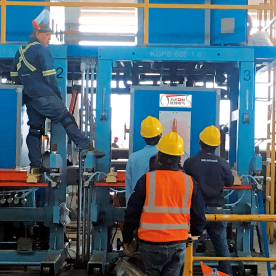[Precision Flying Saw Machine]Revolutionizing Manufacturing: The Role of Precision Flying Saw Machines in Enhancing Cutting Accuracy and Efficiency
News 2024-8-18
In the world of manufacturing and material processing, precision is of utmost importance. As industries strive to improve productivity while reducing waste, innovative equipment has become essential. One such breakthrough technology is the Precision Flying Saw Machine. This advanced cutting solution offers a range of benefits that not only enhance operational efficiency but also improve the overall quality of finished products. In this article, we will explore the fundamentals of Precision Flying Saw Machines, their applications, benefits, and their potential to revolutionize the manufacturing landscape.

Revolutionizing Manufacturing: The Role of Precision Flying Saw Machines in Enhancing Cutting Accuracy and Efficiency
At its core, a Precision Flying Saw Machine is designed to cut materials with extreme accuracy and speed. Unlike traditional saws that rely on stationary blades, flying saws utilize a combination of high-speed rotation and synchronized motion to execute cuts as materials move through the machine. This dynamic operation allows for tight tolerances and can accommodate various types of materials, including metals, plastics, and composites.
The Precision Flying Saw Machine typically features a high-performance circular blade, advanced control systems, and sophisticated software that govern the cutting process. These machines often use programmable logic controllers (PLCs) and computer numerical control (CNC) technology to ensure precise execution of cuts based on pre-defined parameters.
Applications of Precision Flying Saw Machines
Precision Flying Saw Machines are versatile and can be found in numerous industries. Some prominent applications include:
1. **Metal Processing**: In industries such as steel and aluminum fabrication, precision flying saws are used for cutting extrusions, tubes, and pipes. The ability to perform precise cuts reduces scrap and minimizes the need for secondary operations, leading to improved production rates.

Revolutionizing Manufacturing: The Role of Precision Flying Saw Machines in Enhancing Cutting Accuracy and Efficiency
3. **Automotive Manufacturing**: In the automotive sector, precision flying saws are utilized to cut various vehicle components precisely. This precision is crucial for parts that require tight tolerances, such as frame sections, brackets, and structural reinforcements.
4. **Aerospace**: The aerospace industry demands the highest standards of precision due to stringent safety regulations and the critical nature of the components involved. Precision flying saw machines enable manufacturers to achieve the necessary accuracy for producing airframe and engine components.
5. **Woodworking and Composites**: These machines are also adapting to cutting advanced composite materials and engineered woods, which require specific handling to maintain their qualities. Precision flying saws help minimize damage and yield high-quality finished surfaces.
Benefits of Precision Flying Saw Machines
The integration of Precision Flying Saw Machines into manufacturing processes offers several key advantages:
1. **High Speed and Efficiency**: With their capability for continuous motion cutting, flying saws significantly increase processing speeds. This efficiency allows manufacturers to boost output without compromising quality.
2. **Exceptional Accuracy**: Precision flying saws deliver cuts with minimal deviation, significantly improving the quality of the products. This accuracy helps to reduce rework and material wastage, translating into cost savings and better resource management.
3. **Flexibility**: Modern Precision Flying Saw Machines can be easily programmed to execute various cutting operations. This flexibility allows manufacturers to switch between different materials and sizes without the need for extensive reconfiguration.
4. **Reduced Setup Time**: Compared to traditional cutting methods, flying saws generally require less setup time. This reduction boosts productivity, particularly in environments where quick turnaround and just-in-time manufacturing are essential.
5. **Enhanced Worker Safety**: The design of precision flying saws includes safety features that protect operators from potential hazards associated with manual cutting processes. These machines often have enclosed cutting areas and automated controls that minimize operator intervention.

Revolutionizing Manufacturing: The Role of Precision Flying Saw Machines in Enhancing Cutting Accuracy and Efficiency
As industries continue to evolve and embrace advanced technologies, the Precision Flying Saw Machine stands out as a critical innovation in the realm of material processing. Its ability to deliver high-speed, accurate cuts with reduced waste offers significant advantages for manufacturers across various sectors. As companies seek ways to improve efficiency and quality, the adoption of precision flying saw machines will likely become a standard practice, paving the way for new heights in production capabilities. In an era where precision and speed are crucial, these machines represent a forward-thinking solution to meet the challenges of modern manufacturing.
